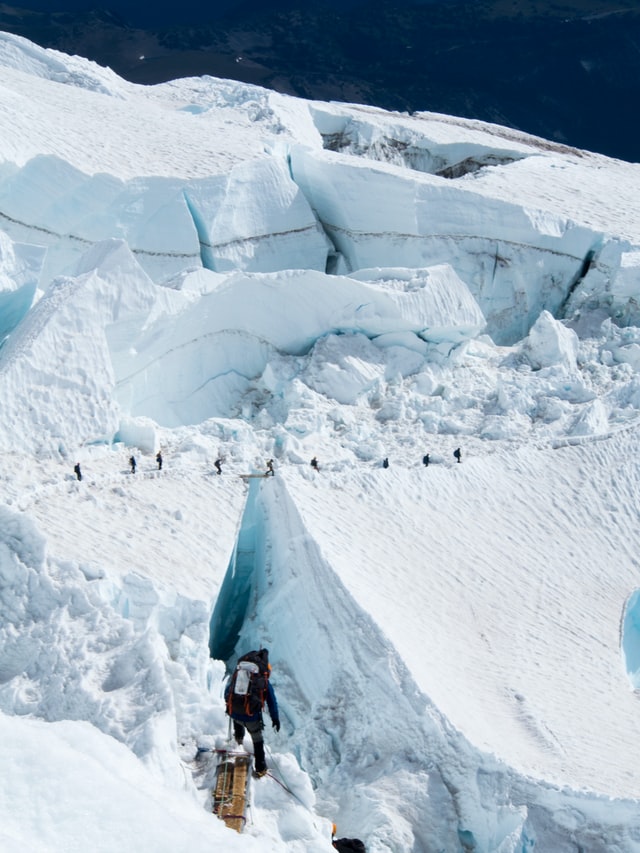
In mountaineering there are – depending on context – three distinct methods to handle the rope:
- Long rope: On (mostly but not always: snow covered) glaciers, teams (of typically 3 or more) rope up with some 10 metres of outstretched rope between them. The remainder of the rope being coiled up around the first and the last member’s upper body.
- Medium length rope: In exposed scrambling/climbing sections (such as block ridges), where additional safety measures can be taken, the rope is held ‘semi’ tight: around 2.5m between members, a good number of that length is coiled up in loops held in the front (wo)man’s hand, to be uncoiled if and when needed to be used on rock jag as a fix point or belaying point .
- Short rope: On firn fields in particular, but also in exposed scrambling/climbing sections (such as of block ridges), where no additional securing measures can be taken, the rope is held tight: in less risky area with a distance of no more – but often less – than 1.5m between two people. The riskier it is the closer the distance between two people gets. Again, much of the remainder of the rope being taken up around the first and the last member’s upper body, and a small fraction of the rope is held coiled up in the hand by each front (wo)man.
The reasons for this widely differing handling can – at its simplest – be broken down as follows:
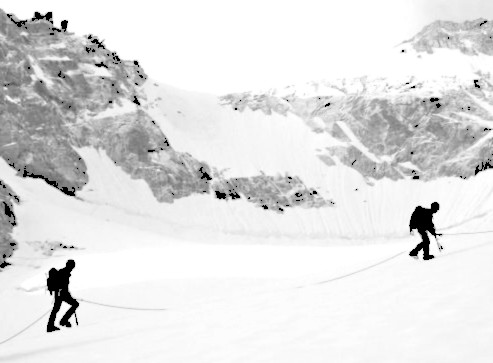
The long rope is used on glaciers in order to minimise the effects of a crevice fall: While the rope must always be tight between two connected members of the rope team, the tight nature of the rope minimises fall depth into a crevice. In addition, it gives sufficient rope to create a pulley and rescue the fallen member by hauling him/her from the crevice.
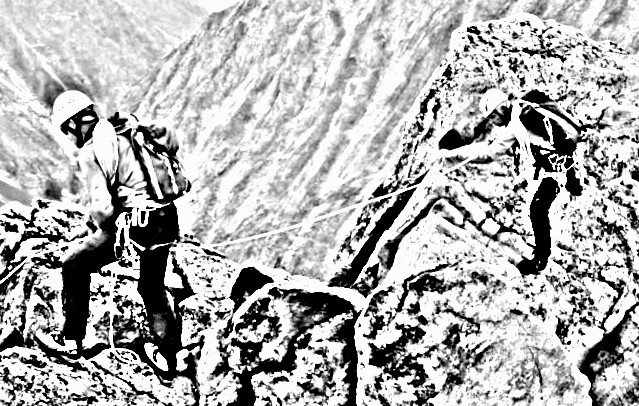
The mid-length rope allows to use rock jags and other natural structures as fix points and/or belaying points. This again allows to secure and belay the moving member/s of the rope team, and minimises the risk of a fatal accident given the circumstances.
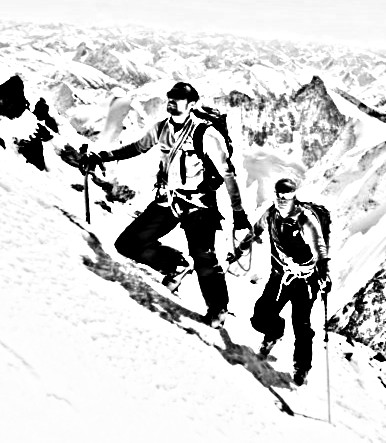
The short rope is used whenever a fall must – and still indeed could – be prevented in its very early stages by limiting the behind rope member’s freedom of movement. At the same time, the shortness of the rope transfers any insecure movement of the behind member swiftly, which means it can – hopefully – be out levelled by the front person. Once a fall happens, there is no rescue but luck; the intent therefore is to remedy the early insecurities that could lead to a fall. The risk therefore is transferred from the weaker rope team member to the stronger one. However, if the worst come to the worst, all fall together.
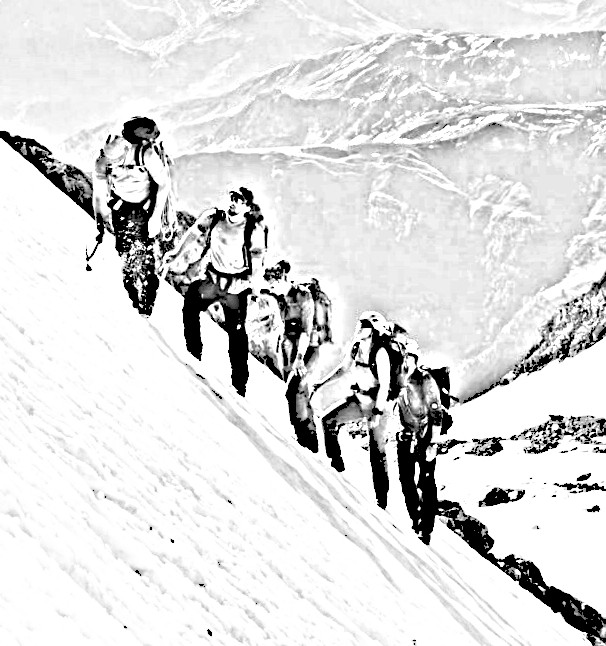
There is fourth though a not often talked about version: the decision to stop using a rope in highly critical situations altogether. This is an method that must be agreed long, long ahead of the situation requiring it, and one that must be consented and in agreement with all members of the team. It comes to bear, if at all, in situations where even the smallest mistake is not permissible: such as an extremely airy ridge where the fall of one person could trigger the fall of the entire team consequence of them being tight to each other (dragging accident). In such situation, path and route finding, as well as pace setting does not differ from roped up teams. However, if indeed one should fall, only a single fatality will likely occur. It goes without saying that the highest risk is with the weakest team member.
Roping techniques and teams: Reflections for the board context
For executives on active duty (the CEO’s, CFOs, COOs as well as those in general management positions): the translation of the above rope techniques to their management approach is fairly straight forward. It is their own personal answer to the question: What situations and risks require what kind of management and leadership technique? How short or long may the managerial leash of a team need to be in any such situation?
The answer is less straight forward for non-executive boards. After all, they by definition should ‘keep their hands out of the tent’ (Quote: Ludo van Heyden) i.e. not play at all an active management role.
The following reflections illustrated why the long and the short leash can have significant impact on how teams operate: their interpersonal communication, and even responsibility and accountability can take on a very different realities.
| Rope Length | Risk | Team | Life or Death |
|---|---|---|---|
| Long | Known to be present. Exact nature, location unknown, and often hidden. | If the risk realises, the whole team is involved. But only one member is directly affected. | Affected team member can and will (normally) be rescued. |
| Mid-length | Mostly visible and present. Skill and experience is normally enough to overcome them. | All team members have to go through the same risky situation, but individually. Learnings, experiences are handed on to subsequent team members. | The strongest goes first. S/he allows some leeway to subsequent members for finding their own way. At the same time the front person exercises a tight enough control so that fatal flaws cannot happen. |
| Short | Mostly visible, present, life threatening. Skill and experience is mostly enough to overcome them. Yet: severe accidents do happen out of exhaustion, inattention, neglect, or bad luck. | The team has to pass through it as one unit. The failing of one may pull the whole team into disaster. | The first/strongest guides the companions while exercising very tight control at all times. The intent is to remedy any insecurity so early that no fatal flaw should happen. |
| Rope-less | Visible, present, life threatening. Skill and experience is mostly enough to overcome them. Yet: severe accidents happen out of exhaustion, inattention, neglect, bad luck. | The team is only a group of independent individuals, each of which has to pass through it on its own account. | Each and everyone is its own master (or disaster, as it were). Moving rope-less implies the willingness to sacrifice the weakest team member for the sake of the survival of the rest of the group. |
Translating alpine roping techniques to the board room
In what kind of situation and circumstances hence could the different roping techniques be applicable – if only metaphorically – in the board setting?
| Rope Length | Example Situation | Team = ? | Example Board Actions | Life or Death |
|---|---|---|---|---|
| Long | The board ensures an appropriate R&D pipeline, including the management and remediation of mutual enhancing potential failures when brought to market. | The board as a whole | The various R&D efforts underway are complementary and innovate in adjacent, but nearly non-overlapping areas. A periodic (e.g. yearly) review ensures this fact. The R&D portfolio is structured such that the unsuccessful launch of one product does not threaten the success of the others. | The board acts as a group in unison and using all complementary expertise that exists amongst them. Their expertise contributes such that any failed individual R&D effort can still be rescued e.g. through sell off. |
| Mid-length | The board is in agreement with the top executives that a specific acquisition should be done. The acquisition could fail and leave the company with reputational damage as well as diminished share prices and strategic challenges. | The board as a whole | Checking on the top executives that adequate precautionary measures are taken and fall back (Plan B) options elaborated. | The board acts as a group in unison and using all complementary expertise that exists amongst them. There is sufficient expertise across the board that there is no single point of failure in regards to their insights. |
| Short | Serious cash flow challenges consequences of the Covid19 pandemic, which puts the businesses survival at risk. | The board as a whole | As a board acts as a team, and keeps the top executives at a fairly tight leash (e.g. short reporting time frames) in regards to the situation and the measures taken. The audit committee may instigate additional in-depth checks and verifications on the effects of measures taken. | The board acts as a group in unison as the survival of the business as a whole is at stake. If the effort fails, all will ‘go under’ together. |
| Rope-less | An erupting scandal – think VW scandal – is a typical example where the board needs to act as a group. Considering the implications, and later on legal investigations, each board member is on his/her own to struggle through the difficulties. | Board of Individual Board Directors. | Facilitate any investigation and/or remediation measure. Ensure the actionability of board of directors’s decisions as a whole in order to facilitate the addressing and remedying of the scandal situation. | Each board member knows that in theory one or several of their colleagues may potentially be identified as guilty or implicated by the investigations. There is acceptance that this may happen. Each will be trying to save his/her own skin. |
Roping techniques is just one way to think about risk, probability of it occurring, team work, diversity of expertise … as well as the consequences of risk realising and fatalities occurring.
It just so happens, that Roping up in the alpine setting, is a very real and tangible illustration of how context, team work and consequences are at interplay. And how relatively simple safety measures (the rope) used as appropriately in the context given (the rope length) can help or hinder a successful outcome.
Roping up is a much needed, but greatly undervalued skill in alpine settings. In a setting hence where the consequences are very palpable and often immediate.
Board context may be less life threatening on the first glimpse, but they are no less varied, no less critical and none less in need of skilful and appropriate handling of leash length and team stronghold.

